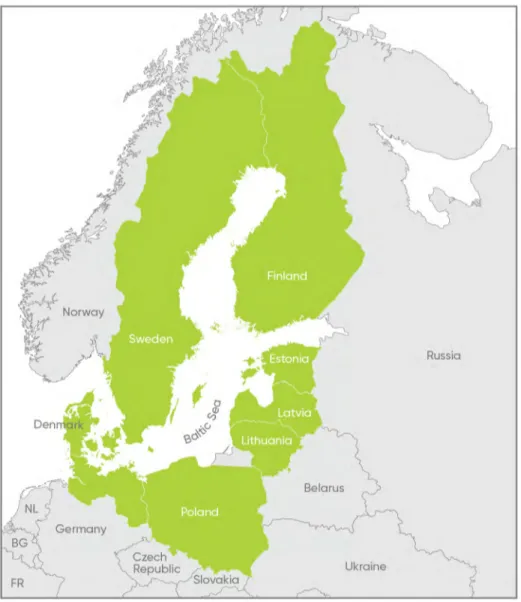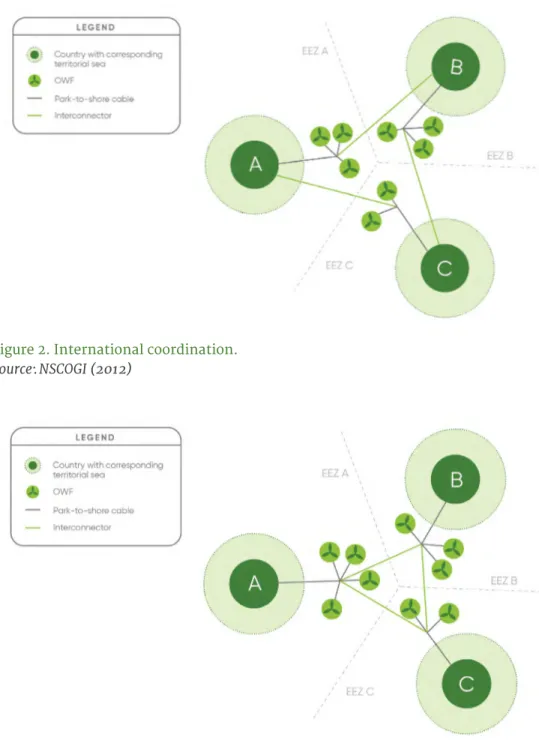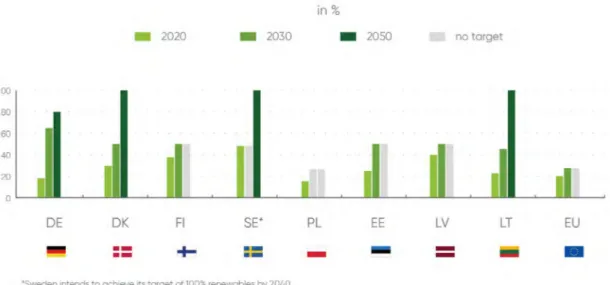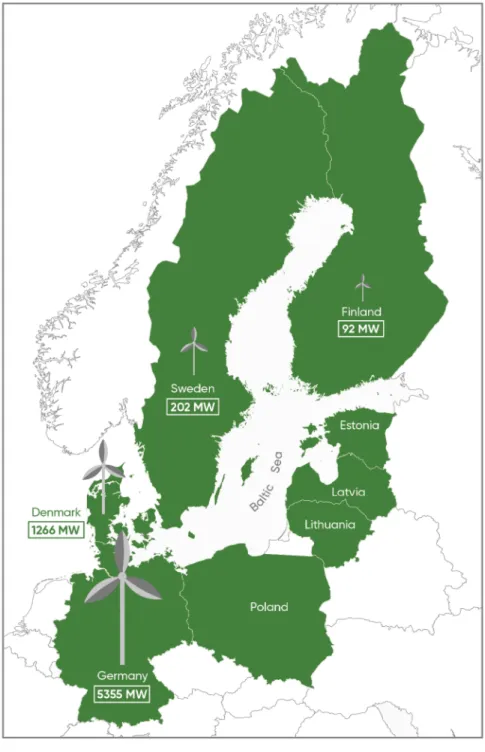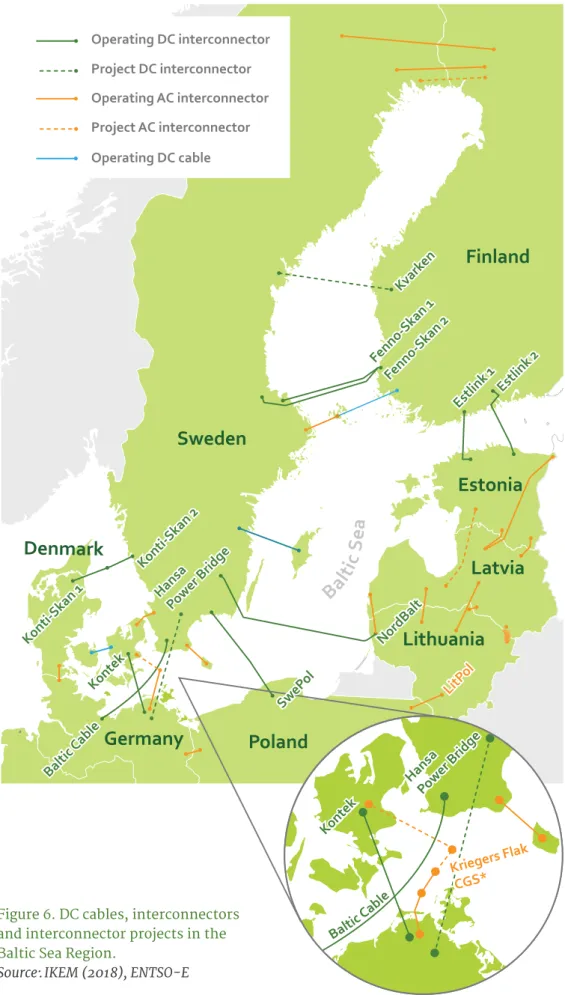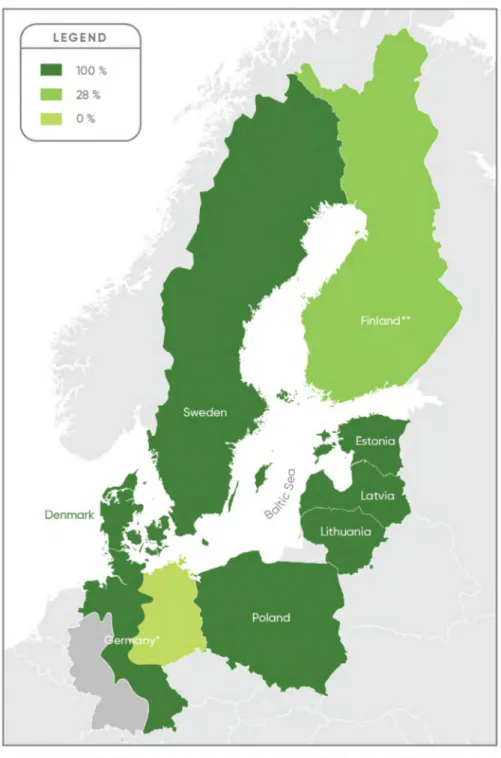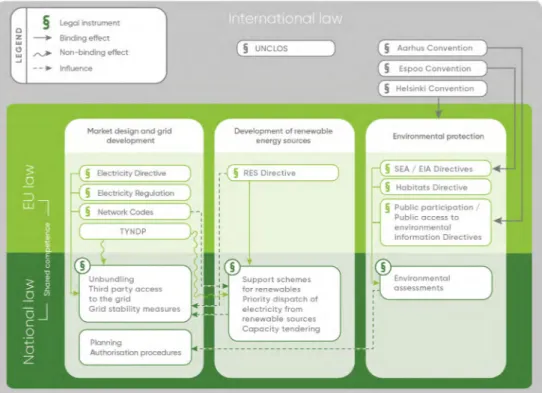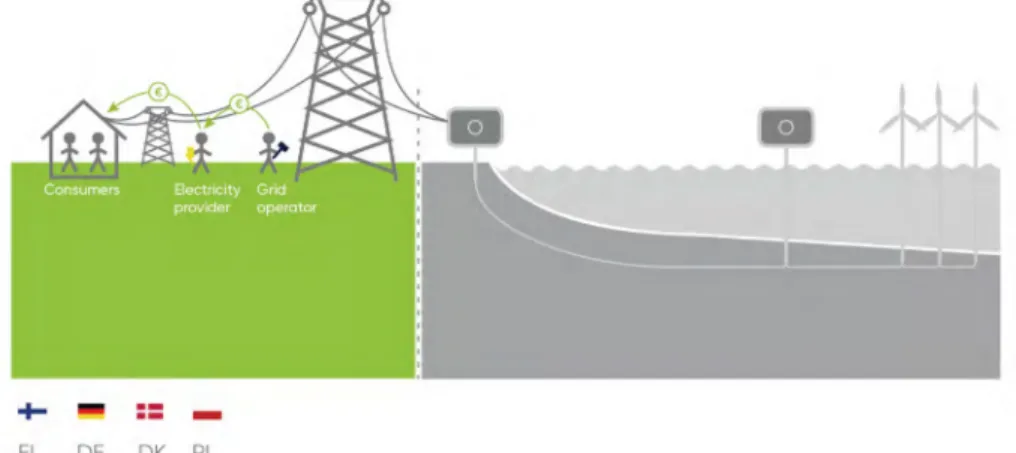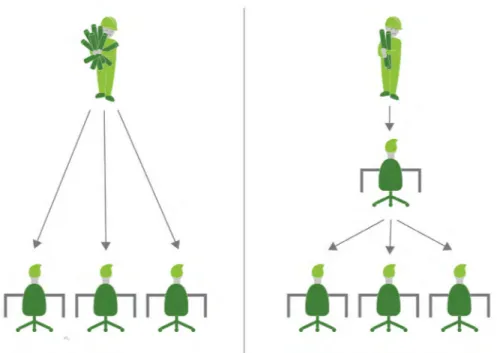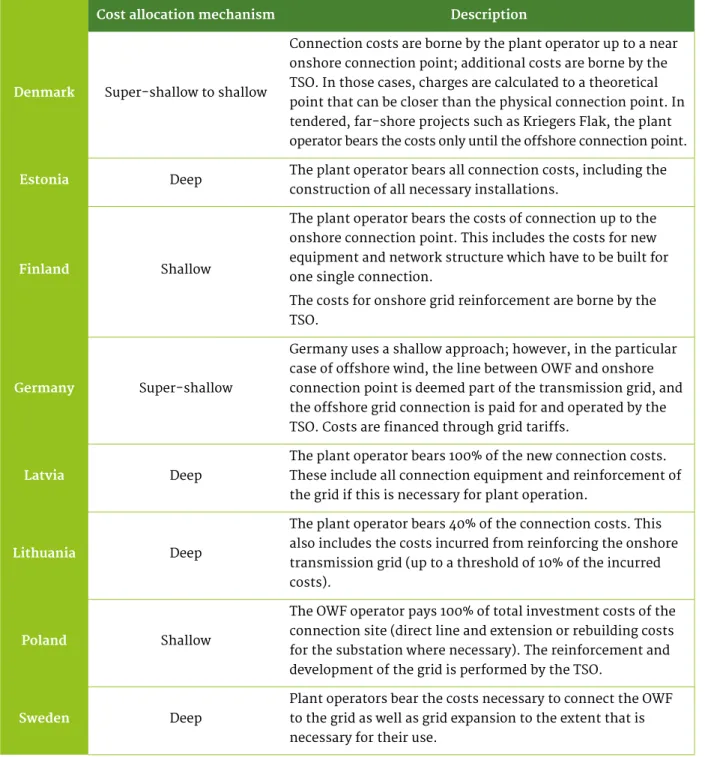wind energy policy in the Baltic Sea Region
A regional status report
June 2018
I Contributors:
Andris Akermanis (Latvian Association of Local and Regional Governments), Claire Bergaentzlé (Technical University of Denmark), Ida Bergmann (Aalto University), Ari Ekroos (Aalto University), Alice Grønhøj (Aarhus University), Pia Isojärvi (Aalto University), Francesca Klein (IKEM), Kristīne Kīlīte (Latvian Association of Local and Regional Governments), Federico Marco (IKEM), Bénédicte Martin (IKEM), Kate Miller (IKEM), Birgitte Egelund Olsen (Aarhus University), Ralph Ott (IKEM), Lise-Lotte Pade (Technical University of Denmark), Kaarel Relve (University of Tartu), Kanerva Sunila (Aalto University), Hannes Veinla (University of Tartu), Daniel Weber (IKEM), Mariusz Wójcik (FNEZ).
Copyright:
Reproduction of this publication in whole or in part must include the customary bibliographic citation, including author attribution, report title, etc.
Cover photo: © Michael Martius Graphics: Ellery Studio
Published by: Baltic InteGrid
Disclaimer:
The content of the report reflects the author’s/
partner’s views and the EU Commission and the MA/JS are not liable for any use that may be made of the information contained therein. All images are copyrighted and property of their respective owners.
Website:
www.baltic-integrid.eu
List of figures and tables II
List of abbreviations III
Summary 1
1. Introduction 2
1.1. Current state of the electricity system in the Baltic Sea Region 2
1.2. Baltic InteGrid research scope 5
2. Policy framework 6
2.1. Renewable energy targets 6
2.2. Offshore wind energy targets 7
2.3. Installed and planned offshore wind energy capacity in the Baltic Sea 8 2.4. Grid expansion and interconnection in the Baltic Sea 8
2.5. Regional cooperation 8
3. Stakeholders 11
3.1. Governments 11
3.2. Transmission system operators in the Baltic Sea Region 11
3.3. Other stakeholders 11
4. Legal framework 13
4.1. International law 13
4.2. EU law 14
4.3. National law 15
4.4. EU Clean Energy Package 16
5. Grid planning and development 17
5.1. Grid development plans 17
5.2. Grid construction permits 17
5.3. Cost distribution for onshore grid enhancement 18
6. Capacity development 19
6.1. Planning phase 19
6.2. Authorisation procedures 19
II III
7. Connection of offshore wind farms to the transmission grid 21
7.1. Connection claims 21
7.2. Procedure 21
7.3. Cost allocation 21
8. Operation 23
8.1. Support schemes for electricity from renewable energy 23
8.2. Incentives beyond support schemes 23
8.3. Priority dispatch 25
8.4. Curtailment 25
9. Challenges and further research 27
References 28
Legal sources 28
Bibliography 29
List of figures
Figure 1. The geography of the Baltic Sea Region. 3
Figure 2. International coordination. 4
Figure 3. Meshed grid. 4
Figure 4. RES-E targets in the EU and Baltic Sea Region countries. 7 Figure 5. Installed offshore wind capacity in the Baltic Sea Region in 2017. 9 Figure 6. DC cables, interconnectors and interconnector
projects in the Baltic Sea Region. 10
Figure 7. Shares of state ownership for TSOs in the Baltic Sea Region. 12 Figure 8. Maritime zones established under the UNCLOS. 13 Figure 9. Levels of legislation and their interactions. 16 Figure 10. Steps in the adoption of the EU Clean Energy Package. 16 Figure 11. Cost distribution for onshore grid enhancement
in a shallow cost allocation model. 18
Figure 12. Cost distribution for onshore grid enhancement
in a deep cost allocation model. 18
Figure 13. Permitting procedures. 20
Figure 14. Cost allocation models. 20
Figure 15. Overview of support schemes for RES-E in the Baltic Sea Region. 25 Figure 16. Identified barriers to the development of
offshore wind energy in a meshed grid. 27
List of abbreviations
BEMIP Baltic Energy Market Interconnection Plan
BSR Baltic Sea Region
DSO Distribution system operator
EEZ Exclusive economic zone
EIA Environmental impact assessment
ENTSO-E European Network of Transmission System Operators for Electricity
EU European Union
NM Nautical mile
NSCOGI North Seas Countries’ Offshore Grid Initiative
OWE Offshore wind energy
OWF Offshore wind farm
PCI Project of common interest
RES Renewable energy sources
RES-E Electricity from renewable energy sources
ROC Regional Operational Centre
SEA Strategic environmental assessment
TEU Treaty on European union
TFEU Treaty on the Functioning of the European Union
TSO Transmission system operator
UNCLOS United Nations Convention on the Law of the Sea
List of tables
Table 1. Cost allocation mechanisms in the Baltic Sea Region countries. 22 Table 2. RES support schemes and priority dispatch in the Baltic Sea Region. 24
1 States and facilitate a safe and sustainable transition to renewable energy. The develop-
ment of offshore wind energy (OWE) in the Baltic Sea Region (BSR), along with the cons- truction of a meshed grid, can contribute significantly to renewable energy production and enhance interconnections between BSR countries. The BSR has great potential to become a major hub for wind energy production but faces significant barriers to integrating regio- nal markets, including asynchronous power systems and energy isolation.
The following report was developed within the scope of Baltic InteGrid (Integrated Bal- tic Offshore Wind Electricity Grid Development), an interdisciplinary Interreg research project bringing together experts from Member States present in the BSR to coordinate the implementation of these policy objectives. The goal of the Baltic InteGrid project is to track current regional, national, and European energy developments and propose recom- mendations to optimise regulatory frameworks. The report examines policy and regula- tory frameworks relevant to the development of OWE and grid infrastructure in the BSR.
It also identifies barriers to this development, which will be addressed in greater detail in future Baltic InteGrid research.
2 3
1. Introduction
One of the original objectives of the EU was to establish a common market that would integrate all of its Member States. A common EU energy market is crucial to this process because energy is an essential factor in the future development of a given territory. A well-functioning EU energy union would supply citizens with secure, affordable and cli- mate-friendly energy. The aim of the EU energy policy is therefore to unify existing energy markets and facilitate a safe and sustainable transition to renewable energy.1 The need to secure internal energy supply, overcome regulatory and technical barriers to energy flows, and address the challenges of climate change are the cornerstones of the EU energy policy.
The development of renewable energy in Europe represents one of the best opportunities to diversify energy sources and develop new and internal supply channels. The BSR has the potential to become a major hub for wind energy production; however, significant barriers to an integrated regional market remain. For example, the BSR is covered by three diffe- rent synchronous power systems (Continental Europe, Nordic and Baltic).2 In addition, the Baltic States still suffer from energy isolation, although they intend to link their power grids to the EU in 2020.3
The goal of this report is to provide an overview of the (offshore wind) energy policy and regulatory schemes in the BSR countries, and to identify barriers to achieving a meshed offshore wind electricity grid. The map in figure 1 shows the geography of the BSR and of the Baltic Sea, which is surrounded by nine countries: eight EU Member States (Denmark, Estonia, Finland, Germany, Latvia, Lithuania, Poland, and Sweden) and the Russian Fede- ration. For the purposes of this report, the BSR is defined as the Interreg Baltic Sea Region programme area limited to EU Member States.
1 European Commission, “Priority Energy Union and climate – Making energy more secure, affordable and sustainable”, https://ec.europa.eu/commission/priorities/energy-union-and-climate_en (accessed 24 May 2018).
2 ENTSO-E, “Systems Operations Committee”, https://www.entsoe.eu/about/system-operations/ (accessed 24 May 2018).
3 Sytas, Andrius, “Baltics states to link power grid to EU as early as 2020, says Lithuania”, Reuters, 7 December 2017, https://www.reuters.com/article/baltics-energy-eu-russia/baltics-states-to-link-power-grid-to-eu-as-early-as- 2020-says-lithuania-idUSL8N1O753A (accessed 24 May 2018).
Figure 1. The geography of the Baltic Sea Region.
Source: Interreg Baltic Sea Region (interreg-baltic.eu)
1.1. Current state of the electricity system in the Baltic Sea Region
1.1.1. Significance of electricity grids
In many countries, infrastructure reflects traditional business models and power dyna- mics. The transition to renewable energy challenges these long-standing relationships.
For energy, and electricity in particular, the most fundamental infrastructure is the grid, which transports energy from its point of production to the point of consumption.
1.1.2. Grids follow the source of energy supply
Today’s grid design follows the pattern of yesterday’s power production. In Germany, for example, transmission grids transport electricity from large power plants, which is then delivered to households via the distribution grids. Because most renewable energy plants are now connected to the distribution grid and prosumer activity is increasing, at times the distribution system operator (DSO) must also feed electricity back into the transmis- sion grid, thus causing power to flow in a reverse direction.
Grid design may also be the result of historical development. For example, the design of energy infrastructure in the Baltic States is a testament to the dependency on Russia as the sole energy provider. In Latvia, for example, much of the power grid was set up on the eastern side, near Russia, to facilitate gas imports. Although Latvia has strong winds on its western coast, it has not installed offshore wind parks; the grid infrastructure in western regions is insufficient to feed wind energy into the grid.
1.1.3. New grids for a new era
Integration of the electricity networks will require the synchronisation of the different electricity networks, as well as the development of cross-border and domestic infrastruc- ture to connect EU Member States. Interconnector links between Lithuania and Sweden (NordBalt), Poland and Sweden (SwePol), and Germany and Denmark (Kriegers Flak Combined Grid Solution) herald a new era of energy supply and transmission in the BSR.
4 5
The introduction of EU interconnection targets and investment in Projects of Common Interest (PCIs) have encouraged this trend. In addition to changes at the EU level, Member States are developing ambitious legal and regulatory reforms in the energy sector that are highly promising for the future of an interconnected grid in the BSR.
1.1.4. Socioeconomic benefits of offshore wind
The Paris climate agreement, which took effect in 2016, has increased public awareness of the risks associated with fossil fuels and the potential economic benefits of clean techno- logy. In spite of their 300-year history of industrialisation, EU Member States have found that emission reductions are not incompatible with economic growth: As part of its tran
sition to a low-carbon society, the EU has decreased emissions by 22% since 1990, even as its gross domestic product has increased by 50%.4 The share of renewables in EU Member States is continuously on the rise (see figure 4).
1.1.5. Wind energy potential in the Baltic Sea
The presence of strong winds has made OWE increasingly attractive to investors, as has the ability to install offshore wind farms (OWFs) out of sight of people on land. In part because of its central location between several countries and its strong wind conditions, the BSR has great potential to provide economic opportunities in the field of renewable energy. In many countries, however, public opposition is a major obstacle to the expansion of renewable energy capacity. Landowners, in particular, have expressed concerns about the operation of power plants in their vicinity, and environmental associations that oppose OWE can legally challenge the permits granted for OWF projects. Addressing these concerns and increasing public acceptance is thus critical to ensuring the development of OWE in the BSR.
1.1.6. Significance of the regulatory framework
Due to the high upfront costs of OWE development, which may deter investors from investing in the technology, the viability of an investment depends greatly on the existing support scheme and regulatory framework. In the BSR, policies have been changing in response to EU reforms and national politics. Although policy may can create more favou- rable conditions for investment, change can also disrupt investment plans. Germany, for example, has now shifted to an auction process, whereby investors submit bids for a fixed electricity price. In some cases (particularly among smaller companies), this transition has rendered plans for OWF development obsolete, while enabling other actors—mainly large companies—to secure areas for new OWFs. German policy reflects conflicting prio- rities: It aims to make renewables more competitive even as it works to ensure diversity among investors from large and small companies, including members of civil society.
1.2. Baltic InteGrid research scope
The EU has demonstrated a clear willingness to promote renewable energy production and grid interconnection. OWE can play a pivotal role in achieving EU energy objectives.
The existing renewable energy targets for each Member State are not subdivided into specific generating sources. Furthermore, the EU does not impose specific measures on Member States. Member States are responsible for defining their energy mix and establishing priorities for different technologies; they decide which measures they will implement to achieve these targets and which stakeholders bear the responsibility for doing so.
The Baltic InteGrid project is designed to advance EU energy policy objectives. The de- velopment of OWE in the Baltic Sea, coupled with the construction of an internationally coordinated or meshed grid (figures 2 and 3)5, can contribute significantly to the develop- ment of RES production and the enhancement of interconnections between BSR countries.
These elements will accelerate progress toward an EU energy union.
4 Šefčovič, Maroš, “Energy Union is about re-inventing our economy”, Euractiv, 7 February 2017, https://www.
euractiv.com/section/energy/opinion/tuesday-energy-union-is-about-re-inventing-our-economy/ (accessed 24 May 2018).
5 For the purpose of this report, we use the grid concepts previously provided by the North Seas Countries’ Offshore Grid Initiative (NSCOGI); see the definitions and deliverables of the Initiative under: Benelux, “North Seas Energy Forum”, http://www.
benelux.int/nl/kernthemas/holder/energie/nscogi-2012-report/ (accessed 24 May 2018).
Figure 2. International coordination.
Source: NSCOGI (2012)
Figure 3. Meshed grid.
Source: NSCOGI (2012)
6 7
2. Policy framework
Policy frameworks are the backbone of legal guidelines. They establish the long-term vision and motivation behind short-term measures. In addition to serving as a justifica- tion of the status quo, political strategies can indicate new trends and developments in a country or region. An overview of the political strategies of BSR countries provides insight into existing policies and future legislation for OWE and grid interconnection.
2.1. Renewable energy targets
Each BSR Member State has set targets for increasing the overall share of renewables in its energy mix. All Member States must achieve a binding renewables target by 2020 in accordance with the EU Renewable Energy Sources (RES) Directive6, with which the EU has committed to fulfil 20% of its gross final energy consumption from renewable sources by 2020.7 The draft Recast RES Directive of the EU Clean Energy Package does not set preci- se binding targets for each country at the EU level, but proposes an EU-wide renewables target of 27% by 2030 with a “fair distribution of efforts by Member States”,8 which was increased in June 2018 during EU interinstitutional negotiations to 32%.9
The BSR countries have also set RES targets for 2030, 2040 and/or 2050. Most countries have established a target for 2030. Sweden aims to fulfil 100% of its electricity needs with renewables by 204010; Denmark11 and Lithuania12 intend to do so by 2050. Based on its Na- tional Energy and Climate Strategy, Finland intends to become carbon-neutral until 2050;
however, it has not yet set a 2050 renewable energy target13; instead, a 50% target is set for 2030.14
6 Directive 2009/28/EC of the European Parliament and of the Council of 23 April 2009 on the promotion of the use of energy from renewable sources and amending and subsequently repealing Directives 2001/77/EC and 2003/30/EC, OJ L 140, 5.6.2009, p. 16–62.
7 Art. 3 par. 1 RES Directive.
8 Proposal for a Directive of the European Parliament and the Council on the promotion of the use of energy from renewable sources (recast), COM(2016) 767 final/2 2016/0382/COD, p. 8.
9 European Commission – Statement, “Europe leads the global clean energy transition: Commission welcomes ambitious agreement on further renewable energy development in the EU”, 14 June 2018, http://europa.eu/rapid/
press-release_STATEMENT-18-4155_en.htm (accessed 22 June 2018).
10 Government Offices of Sweden, “Government making broad investments in energy”, 21 September 2017, https://
www.government.se/press-releases/2017/09/government-making-broad-investments-in-energy/ (accessed 24 May 2018).
11 March 2012 Energy Agreement, available at Danish Energy Agency, Energiaftalen 22. marts 2012, https://ens.dk/
ansvarsomraader/energi-klimapolitik/politiske-aftaler-paa-energiomraadet/energiaftalen-22-marts-2012.
12 WindEurope, “Lithuania significantly steps up its wind energy ambitions with new National Energy Strategy”, 15 June 2018, https://windeurope.org/newsroom/news/lithuania-significantly-steps-up-its-wind-energy-ambitions- with-new-national-energy-strategy/ (accessed 20 June 2018).
13 Ministry of Economic Affairs and Employment, Government report on the National Energy and Climate Strategy for 2030, p. 9, available at https://tem.fi/documents/1410877/2769658/Government+report+on+the+National+Energ y+and+Climate+Strategy+for+2030/0bb2a7be-d3c2-4149-a4c2-78449ceb1976
14 Prime Minister’s Office Finland (2015), Finland, a land of solutions – Strategic Programme of Prime Minister Juha Sipilä’s Government, p. 24, available at https://valtioneuvosto.fi/documents/10184/1427398/Ratkaisujen+Suomi_
EN_YHDISTETTY_netti.pdf/8d2e1a66-e24a-4073-8303-ee3127fbfcac/Ratkaisujen+Suomi_EN_YHDISTETTY_
netti.pdf.pdf.
Figure 4. RES-E targets in the EU and Baltic Sea Region countries.
Source: IKEM (2018)
2.2. Offshore wind energy targets
In Germany, the development pathway is legally prescribed: the Offshore Wind Energy Act calls for the installation of 15 GW by 2030, including at least 3.3 GW in the Baltic Sea.15 Although this target has been criticised as insufficiently ambitious, it has at least created legal certainty; this, in turn, may be one of the factors that encouraged tenderers to submit zero-subsidy bids for OWF operation – hence without state support.16
In Denmark, OWE targets for the period 2012-2020 aiming to establish a 400 MW OWF at Horns Rev, 600 MW at Kriegers Flak and 500 MW in coastal areas were set in the 2012 Energy Agreement, a political agreement between a majority of the political parties of the Danish Parliament.17 Though not formally binding law, such agreements traditionally se- cure political stability to the targets.
In Lithuania, the Parliament recently adopted its National Energy Strategy which, among other measures, sets up an auction scheme for wind energy, to begin in 2019, with the overall target of having 2,300 MW of offshore wind capacity installed by 2030.18
The other countries in the BSR have not set specific offshore wind targets, which makes it difficult to predict the future trajectory of OWE development in the Baltic Sea and gene- rates uncertainty among investors.
15 Federal Network Agency (2017), Bedarfsermittlung 2017–2030: Bestätigung, Offshore Netz-Entwicklungsplan (Offshore Network Development Plan 2030/O-NEP), p. 19, available at https://www.netzentwicklungsplan.de/sites/
default/files/paragraphs-files/O-NEP_2030_2017_Bestaetigung.pdf.
16 BNetzA, “Bundesnetzagentur erteilt Zuschläge in der ersten Ausschreibung für Offshore-Windparks”, 13 April 2017, https://www.bundesnetzagentur.de/SharedDocs/Pressemitteilungen/DE/2017/13042017_WindSeeG.html (accessed 24 May 2018).
17 Danish Energy Agency, Energiaftalen 22. marts 2012, at https://ens.dk/ansvarsomraader/energi-klimapolitik/
politiske-aftaler-paa-energiomraadet/energiaftalen-22-marts-2012.
18 WindEurope, “Lithuania significantly steps up its wind energy ambitions with new National Energy Strategy”, 15 June 2018, https://windeurope.org/newsroom/news/lithuania-significantly-steps-up-its-wind-energy-ambitions- with-new-national-energy-strategy/ (accessed 20 June 2018).
8 9
2.3. Installed and planned offshore
wind energy capacity in the Baltic Sea
Only four of the eight countries represented in the Baltic InteGrid project have installed offshore wind power (see figure 5).19 As of 2017, the installed capacity of Germany’s 23 OWFs was 5,355 MW, produced by 1,169 connected turbines. Denmark was second, with a total of 506 turbines in 12 OWFs and an installed capacity of 1,266 MW. Sweden had five OWFs with 86 connected turbines and an overall capacity of 202 MW. Finland closed out the list with 92 MW of installed capacity from 28 turbines, distributed across three OWFs.
Estonia and Poland currently do not have any installed OWP capacity, but both countries intend to develop this sector.20
2.4. Grid expansion and interconnection in the Baltic Sea
The EU has set a 10% interconnection target for each Member State, to be achieved by 2020.21 Denmark, Germany and Finland plan to expand their respective grids in the Baltic Sea. These are also the only three countries in the BSR to have reached their EU 2020 interconnection target of 10%. The EU Clean Energy Package sets a 2030 interconnection target of 15%. Figure 6 shows existing and planned AC and DC interconnections in the Baltic Sea Region, as well as national DC connections in the Baltic Sea.
2.5. Regional cooperation
Some regional agreements specify initiatives to improve regional cooperation between EU Member States in the BSR and incentivise cross-borders investments.
The Baltic Energy Market Interconnection Plan (BEMIP) aims to strengthen cooperation between EU Member States in the BSR, in part by improving cross-border interconnection between Baltic States to eliminate “energy islands”. The BEMIP also develops Action Plans that identify measures and projects appropriate to accomplish its objectives. Projects fun- ded and planned through the BEMIP include the LitPol Link between Poland and Lithuania, and Nordbalt between Lithuania and Sweden.22 The BEMIP also advances the overall EU Strategy for the BSR.
Under the BEMIP, the three Baltic States will be integrated into NORDEL, the nordic electricity market model. These links will facilitate interconnection by eliminating trade barriers in the energy market (including energy tariffs) and establishing common energy reserves and power exchanges to reduce congestion.23
19 WindEurope (2018): Offshore Wind in Europe: Key trends and statistics 2017, p. 18, https://windeurope.org/wp-content/
uploads/files/about-wind/statistics/WindEurope-Annual-Offshore-Statistics-2017.pdf (accessed 24 May 2018).
20 OffshoreWIND.biz, “Estonia Targets 2030 with Offshore Wind”, 1 November 2017, https://www.offshorewind.
biz/2017/11/01/estonia-targets-2030-with-offshore-wind/ (accessed 24 May 2018); WindEurope, “Ambitious 8 GW of offshore wind planned that will put Poland back on wind energy map”, 11 April 2018, https://windeurope.org/
newsroom/press-releases/ambitious-8gw-of-offshore-wind-planned-that-will-put-poland-back-on-wind- energy-map/ (accessed 24 May 2018).
21 European Commission, “Electricity interconnection targets”, https://ec.europa.eu/energy/en/topics/infrastructure/
projects-common-interest/electricity-interconnection-targets (accessed 24 May 2018).
22 European Commission, “Baltic Energy Market Interconnection Plan”, https://ec.europa.eu/energy/en/topics/
infrastructure/trans-european-networks-energy/baltic-energy-market-interconnection-plan (accessed 24 May 2018).
23 Keep.eu, “Project – Extend the Nordic electricity market model (NORDEL) to the three Baltic States”, https://
www.keep.eu/keep/project-ext/40500/Extend%20the%20Nordic%20electricity%20market%20model%20
%28NORDEL%29%20to%20the%20three%20Baltic%20States (accessed 24 May 2018).
The EU advocates for further regional cooperation in the energy sector. In accordance with the recast Electricity Regulation of the Clean Energy Package24, the European Network of Transmission System Operators for Electricity (ENTSO-E) aims to promote further cooperation at the regional level and ensure interoperability, communication, and mo- nitoring in areas where harmonisation has not yet been achieved. Regional Operational Centres (ROCs) have been proposed to strengthen and coordinate cooperation amongst TSOs at the regional level.25
24 Proposal for a Regulation of the European Parliament and of the Council on the internal market for electricity (recast), COM/2016/0861 final/2 - 2016/0379 (COD).
25 Art. 32 recast Electricity Regulation.
Figure 5. Installed offshore wind capacity in the Baltic Sea Region in 2017.
Source: IKEM (2018), WindEurope (2018): Offshore Wind in Europe: Key trends and statistics 2017
10 11
Figure 6. DC cables, interconnectors and interconnector projects in the Baltic Sea Region.
Source: IKEM (2018), ENTSO-E
Finland
Sweden
Estonia
Latvia
Lithuania
Poland Denmark
Germany
Ba lti c Se a
Operating DC interconnector
Operating AC interconnector
Operating DC cable Project DC interconnector
Project AC interconnector
Konti -Skan 2
SweP ol
Fenno- Skan 2 Kvark
en
Fenno- Skan 1
Estlink 1 Estlink 2
Baltic Cable Konti
-Skan 1
Hansa Power Bri
dge
NordBalt Kontek
Sweden
Denmark
Baltic Cable
Kriegers Flak CGS*
Kontek
Hansa Power Bri
dge LitP
ol
3. Stakeholders
3.1. Governments
Ministries of economic affairs in Germany, Finland, Estonia, and Latvia are responsible for OWE. In Denmark, Sweden, Poland, and Lithuania, a separate Ministry of Energy makes decisions on OWE-related energy issues. Ministries responsible for energy generally have a favourable view of OWE, and most environmental ministries and regulatory agencies for energy and the environment support offshore wind. The Latvian Ministry of Economics, however, has expressed opposition to the provision of offshore wind subsidies under cur- rent economic conditions.26
3.2. Transmission system operators in the Baltic Sea Region
As a result of States’ historical monopoly over grid infrastructure, most TSOs in the BSR remain state-owned. One exception is the German TSO 50Hertz, which operates in the Baltic Sea and is owned by two private companies.27 In continental Finland, the State holds an approximate 28% stake of the TSO Fingrid Oyj.28
3.3. Other stakeholders
Attitudes toward OWFs vary among civil society organisations. Environmental organi- sations have had mixed reactions to offshore wind. Some have shown support due to the environmental benefits of clean energy, but concerns have been raised about the invasive environmental effects of OWFs. The German NGO Nature and Biodiversity Conservation Union (Naturschutzbund Deutschland e.V. [NABU]), an association of 530,000 members, has expressed an unfavourable view of offshore wind development.29
In addition, consumer associations have raised concerns that the higher relative costs of OWE may lead to rising energy prices. Some industries (including fishing, oil and gas transportation/exploitation, and tourism industries) have also been reluctant to support OWE development due to its potential impact on their economic activities. Although ship- ping operators have expressed reservations, new business opportunities in wind-related shipping may compensate for any losses resulting from the obstruction of shipping rou- tes.
OWE development has won the enthusiastic support of wind energy associations and other economic actors in the wind energy sector, for example the Danish Wind Industry Association, the Estonian Wind Power Association, and the German Bundesverband Win- dEnergie e.V. (BWE) and Stiftung OFFSHORE-WINDENERGIE.
26 Baltic InteGrid workshop “Offshore Wind Energy Infrastructure: Opportunities and Challenges in Latvia”, Riga, 15 May 2017.
27 50Hertz, “Investors”, https://www.50hertz.com/en/50Hertz/About-us/Finance/Investors (accessed 24 May 2018).
28 The Republic of Finland holds 28.24% of the TSO shares, while the National Emergency Supply Agency holds 24.90%, bringing the public share in the TSO to a total of 53.14%; Fingrid OYJ, “Shares and Shareholders”, https://
www.fingrid.fi/en/pages/investors/shares-and-shareholders/ (accessed 24 May 2018).
29 NABU, “Offshore-Windkraft in Deutschland – Chance fürs Klima - Risiko für die Meere”, https://www.nabu.de/
natur-und-landschaft/meere/offshore-windparks/index.html (accessed 24 May 2018).
12 13
Figure 7. Shares of state ownership for TSOs in the Baltic Sea Region.
Source: IKEM (2018)
4. Legal framework
The legal framework relevant for the development of OWE is present at three different levels: conventions and agreements under international law; EU law and its implemen- tation in Member States; and national law regulating matters that does not fall under the scope of EU law. These different levels of law interact with and have a significant influence on one another, as presented in figure 9 below.
4.1. International law
4.1.1. UNCLOS
Rules governing the use of international seas are codified in the United Nations Conven- tion on the Law of the Sea (UNCLOS), which provides a general framework for the extent of national sovereignty over maritime areas. The Convention, signed in 1982 and ratified by over 150 countries, establishes distinct maritime areas, including the territorial sea, the Exclusive Economic Zone (EEZ), the continental shelf, and the high seas. Due to its geographical features, the Baltic Sea has no high seas.
All waters within 12 nautical miles (NM) of a state’s shoreline are its territorial sea. The state has full sovereignty over the waters in this zone. Beyond the territorial sea are the EEZ and continental shelf. Every state can establish an EEZ within the waters adjacent to its territorial sea, up to 200 NM from the coast. The sovereign rights enjoyed by states are limited and may be granted only for activities of an economic nature. Within its own EEZ, a coastal state also has the right to explore and exploit natural resources; to esta- blish and use artificial islands, installations, and structures; and to authorise and regulate drilling. In addition, it is entitled to exploit the continental shelf in its waters. However, other states have the right of navigation and can lay submarine cables and pipelines in the EEZ of another state. Provisions applicable to the EEZ are relevant since many OWFs are located within this zone.
Territorial sea - 12 NM
EEZ - 200 NM High sea
Continental shelf Coastal state sovereign territory
Figure 8. Maritime zones established under the UNCLOS.
Source: IKEM (2018)
14 15
4.1.2. Other relevant conventions
4.1.2.1. Helsinki Convention
The Convention on the Protection of the Marine Environment of the Baltic Sea Area (Hel- sinki Convention)30 seeks to prevent and eliminate pollution from a variety of sources in order to promote the ecological restoration of the BSR and preserve its ecological balance.
4.1.2.2. Espoo Convention
Under the Convention on Environmental Impact Assessment in a Transboundary Con- text (Espoo Convention)31 and its Protocol on Strategic Environmental Assessment (Kyiv Protocol)32, an environmental assessment of projected activities and conceptual plans is required to prevent any significant adverse transboundary impact. This convention was implemented at the EU level through the EIA and SEA Directives.33
4.1.2.3. Aarhus Convention
The 1998 United Nations Economic Commission for Europe Convention on Access to Infor- mation, Public Participation in Decision-making and Access to Justice in Environmental Matters (Aarhus Convention)34 grants the public the right to access environmental infor- mation and justice, as well as to participate in environmental decision-making.35 It was implemented in the EU by the Public Participation Directive36, which gives environmental organisations the right to pursue legal proceedings against planned projects.
4.2. EU law
Under Art. 4 of the Treaty on European Union (TEU), the EU and Member States share com- petences over energy law, so that both the EU and Member States may adopt legislation on energy-related issues. According to Art. 194 par. 1 of the Treaty on the Functioning of the European Union (TFEU), EU energy policy seeks to ensure the functioning of the energy market and security of supply in the EU and to promote the interconnection of energy networks.
The European common energy market is designed largely on the basis of secondary EU legislation. The legislative package currently in force37 is the EU’s Third Energy Package, which was proposed by the Commission and adopted by the EU legislature in 2009 to make the energy market fully effective and create a single EU energy market. It consists of se- veral acts of secondary EU law and regulates matters such as the opening of the electricity
30 Convention on the protection of the marine environment of the Baltic Sea area (Helsinki Convention), text available at http://www.helcom.fi/Documents/About%20us/Convention%20and%20commitments/Helsinki%20 Convention/1992_Convention_1108.pdf.
31 Convention on Environmental Impact Assessment in a Transboundary Context, United Nations, Treaty Series, Volume 1989, p. 309.
32 Protocol on Strategic Environmental Assessment to the Convention on Environmental Impact Assessment in a Transboundary Context, text available under https://www.unece.org/fileadmin/DAM/env/eia/documents/legaltexts/
protocolenglish.pdf.
33 European Commission, “Environmental Impact Assessment – EIA”, last modified 2 February 2017, http://ec.europa.
eu/environment/eia/eia-legalcontext.htm (accessed 24 May 2018).
34 United Nations, “Treaty Series”, Volume 2161, p. 447.
35 European Commission, “The Aarhus Convention”, last modified 2 March 2017, http://ec.europa.eu/environment/
aarhus/ (accessed 18 May 2018).
36 Directive 2003/35/EC of the European Parliament and of the Council of 26 May 2003 providing for public participation in respect of the drawing up of certain plans and programmes relating to the environment with regard to public participation and access to justice and amending Council Directives 85/337/EEC and 96/61/EC, OJ L 156, 25.06.2003, p. 17–25.
37 At the time of redaction (June 2018).
market, ownership unbundling in grid operation, market access, and the establishment of national energy regulatory authorities.38
The RES Directive establishes a framework for the development of energy renewable sources in the EU.39 It defines “energy from renewable sources” as energy from renewable non-fossil sources (e.g., wind)40 and establishes accounting rules for electricity generated from hydro and wind power.41
The Internal Electricity Market Directive (Electricity Directive)42 sets rules for the organisa- tion and functioning of an integrated and competitive EU electricity market43 and promotes re- gional cooperation.44 To facilitate coordination, electricity networks are operated according to the rules set out in the Regulation on Conditions for Access to the Network for Cross-border Exchanges in Electricity (Electricity Regulation)45 and the EU Network Codes and Guidelines, which are also binding legal instruments.46
The Strategic Environmental Assessment Directive (SEA Directive)47 requires Member States to ensure that environmental assessments are carried out for public plans or programs that may impact the environment significantly.48 By contrast, the provisions of the Environmental Impact Assessment Directive (EIA Directive) apply to concrete project planning.49
4.3. National law
The provisions of national legislation vary among BSR countries. In addition to the necessary implementation of EU directives, legal frameworks of the BSR countries include requirements for permitting procedures and environmental assessments, RES-E support schemes and grid operation.
Versatility is a feature common to all of these national legal frameworks. For example, the German Renewable Energy Act has been revised eight times since it first entered into force in 2000. In Latvia, the current feed-in tariff is suspended; a new support mechanism for electri- city from renewable sources may be introduced by the end of 2018, although its prospects for passage are still uncertain. The ever-changing regulatory framework—as well as the lack of clear political will to offer specific support for OWE development—may discourage invest- ment in offshore wind technology.
38 European Commission, “Questions and Answers on the third legislative package for an internal EU gas and electricity market”, last modified 19 February 2018, europa.eu/rapid/press-release_MEMO-11-125_en.htm?locale=en (accessed 18 May 2018).
39 Art. 1 RES Directive.
40 Art. 2 (a) RES Directive.
41 Annex II RES Directive.
42 Directive 2009/72/EC of the European Parliament and of the Council of 13 July 2009 concerning common rules for the internal market in electricity and repealing Directive 2003/54/EC, OJ L 211, 14.08.2009, p. 55–93.
43 Art. 1 Electricity Directive.
44 Art. 6 par. 1 Electricity Directive.
45 Regulation (EC) No 714/2009 of the European Parliament and of the Council of 13 July 2009 on conditions for access to the network for cross-border exchanges in electricity and repealing Regulation (EC) No 1228/2003, OJ L 211, 14.08.2009, p. 15–35.
46 European Commission, “Electricity network codes and guidelines”, https://ec.europa.eu/energy/en/topics/markets-and- consumers/wholesale-market/electricity-network-codes (accessed 25 May 2018).
47 Directive 2001/42/EC of the European Parliament and of the Council of 27 June 2001 on the assessment of the effects of certain plans and programmes on the environment, OJ L 197, 21.7.2001, p. 30–37.
48 European Commission, “Strategic Environmental Assessment (SEA)”, last modified 6 February 2018, http://ec.europa.eu/
environment/eia/sea-legalcontext.htm (accessed 25 May 2018).
49 Directive 2011/92/EU of the European Parliament and of the Council of 13 December 2011 on the assessment of the effects of certain public and private projects on the environment, OJ L 26, 28.1.2012, p. 1–21.
16 17
4.4. EU Clean Energy Package
The European Commission presented its Clean Energy Package (also known as the “Win- ter Package”) on 30 November 2016. The legislation contains proposals for reforming directives on renewable energy, the electricity market, energy efficiency, ecodesign, and governance, as well as regulations on the energy agency and electricity market. The Clean Energy Package is expected to come into force in 2019.50 Its content is likely to change before then in the course of the legislative procedure.51 Figure 10 shows the different steps of the legislative procedure leading to the adoption of the legal instruments of the Clean Energy Package and their transposition by the Member States.
50 At the time of redaction, the European Parliament and the Council of Ministers are reviewing the proposals as part of the trilogue phase of the legislative procedure.
51 The current status of the Package’s legislative proposals is available at European Commission, “Clean Energy for All Europeans”, https://ec.europa.eu/energy/en/topics/energy-strategy-and-energy-union/clean-energy-all- europeans (accessed 24 May 2018).
Figure 9. Levels of legislation and their interactions.
Source: IKEM (2018)
Figure 10. Steps in the adoption of the EU Clean Energy Package.
Source: IKEM (2018)
5. Grid planning and development
5.1. Grid development plans
Member States in the BSR develop non-binding grid development plans that identify the country’s needs for grid development and expansion on the basis of energy demand. In Denmark and Finland, these plans also indicate anticipated interconnections with neig- hbouring countries. The environmental impact of grid development plans is evaluated through an SEA.
5.1.1. Responsibility
In all BSR Member States, the TSOs are responsible for grid development. Germany is the only country whose public authority actively participates in drafting the plan; the Federal Network Agency, the German regulatory authority, approves the grid development plan drafted by the four TSOs. Following a 2017 reform, the Federal Office of Navigation and Hydrography is also competent to draft maritime spatial plans in the North and Baltic Sea, and determines corridors for the offshore transmission grid.
5.1.2. Chronology
Although the chronology of OWF and grid development processes varies among BSR countries, in all cases it is vital for the location of offshore wind farms to be compatible with the grid infrastructure. Estonian and Latvian plans for energy generation are develo- ped before the grid, while, in Finland and Denmark, both are planned together. In Germa- ny, the grid is planned before available space is tendered for OW development following the 2017 reform.
5.1.3. Public participation
Few BSR countries grant the public an opportunity to participate in the grid development process. In Denmark, for example, the grid development plan is publicly accessible, but there is no formal period for public consultation. In Finland, only customers of the TSO are consulted. In Latvia, the public has no right to participate in the process, although the TSO may demand information from system users.52 Germany, on the other hand, has integrated a period for formal public consultation into the grid development process.53
5.2. Grid construction permits
In all BSR countries except Lithuania54 the permit process for laying cables is distinct from the authorisation process for power plant construction and operation. The complexity of the cable permit process varies among the Member States. In Denmark, for example, grid construction only requires approval from the competent ministry.55 In Germany, on the other hand, three separate procedures may apply, depending on whether the cables are located in the EEZ or in territorial seas that traverse multiple German federal states (Bundesländer); the relevant legal provisions and competent administrative authority vary accordingly.
52 Sec. 15 Electricity Market Law (Elektroenerģijas tirgus likums published on: Latvijas Vēstnesis, 82 (3240), 25.05.2005, Ziņotājs, 12, 22.06.2005).
53 Federal Ministry for Economic Affairs and Energy, “Grid expansion is an indispensable part of the energy transition”, https://www.bmwi.de/Redaktion/EN/Artikel/Energy/electricity-grids-of-the-future-02.html (accessed 25 May 2018).
54 Tallat-Kelpšaitė, Jurga, “Connection to the grid: procedure”, RES Legal, last updated 26 September 2017, http://
www.res-legal.eu/search-by-country/lithuania/single/s/res-e/t/gridaccess/aid/connection-to-the-grid-25/
lastp/159/ (accessed 25 May 2018).
55 Part 2 Sec. 4a Act on Energinet.dk (Consolidation Act no. 224 of 16 March 2009 as amended by L 2009-06-12 no.
516, L 2010-06-12 no. 622 and L 2011-05-18 no. 466.).
18 19
5.3. Cost distribution for onshore grid enhancement
If the onshore transmission grid lacks capacity, additional grid development is required to integrate wind-generated power. As a result, in addition to the costs of connecting the OWF to the transmission grid, other expenses may be incurred for the expansion and de- velopment of onshore grid infrastructure. These grid development costs are distributed in accordance with the relevant national legal framework and may be based on a different cost-sharing mechanism than is used to connect OWFs to the transmission grid.
In some countries such as for example Germany or Poland, the grid operator initially be- ars costs but can pass these on to consumers through utility companies (figure 11).56 In Denmark, a 1998 parliamentary decision imposing a Public Service Obligation fee allowed operators to recoup costs through a consumer-paid electricity tariff57; the controversial fee was found to violate EU law and discontinued in 2016, shifting the financial burden from consumers to the national budget. In other countries, for example Estonia or Lithua- nia, plant operators bear the costs of grid enhancement (figure 12).58
56 This corresponds to a shallow cost allocation, see below under 7.3.
57 Danish Ecological Council and Green Budget Europe (2016): Fact Sheet: Financing renewable energy, p. 1, https://
www.ecocouncil.dk/en/documents-3/andet/2176-171130-fact-sheet-financing-renewable-electricity/file.
58 This corresponds to a deep cost allocation, see below under 7.3.
Figure 11. Cost distribution for onshore grid enhancement in a shallow cost allocation model.
Source: IKEM (2018)
Figure 12. Cost distribution for onshore grid enhancement in a deep cost allocation model.
Source: IKEM (2018)
6. Capacity development
6.1. Planning phase
The procedure for determining the location of OWFs varies in accordance with the specific legal framework established in each BSR country. Some countries decide on the location of OWFs through capacity auctions. In Germany, the 2017 reform introduced a procedure in which the Federal Network Agency solicits bids for capacity in the North and Baltic Sea.
The available capacity is allocated to installations in designated areas, with a quota of at least 500 MW awarded to OWFs in the Baltic Sea.59 In Denmark, the Danish Energy Agency tenders an OWF of a certain size within a predefined geographical area.60
In countries that do not offer tenders, OWF development is subject to fewer constraints but must still take into account maritime spatial plans and relevant legal provisions. For example, Poland prohibits OWF construction in territorial seas, effectively limiting such development to the EEZ.
6.2. Authorisation procedures
Because the legislation governing OWF permits is issued at the national level, permit pro- cedures vary significantly among BSR countries.
Most procedures involve multiple permits, including for example water permits, elec- tricity generation permits, or permits to use the sea bed. Such complex administrative procedures may lengthen the permit phase and deter project developers from investing in OWE. Furthermore, permits are often granted by different public authorities and wit- hin different time frames. Pursuant to the Member States’ administrative law, individual permits can usually be legally challenged by opponents, as in the case of the proposed wind farm near Estonia’s Hiiumaa island.61 The ensuing legal uncertainty may also deter investors.
In some countries however, the OWF permitting procedure involves a one-stop shop, which means that the project developer applies for an all-encompassing permit to cons- truct and operate the OWF (figure 13). Competent for this procedure is a single administ- rative authority, which independently examines the conditions for all necessary permits or involves other administrative authorities in the process. This design increases the transparency of the process and saves time. Countries with one-stop shops are Germany and Denmark; Sweden has a one-stop shop for OWFs situated in its EEZ.
The current EU Clean Energy Package draft proposes a one-stop shop for all renewable facilities: the recast RES Directive requires Member States to establish one administrative contact point that will coordinate the entire approval process.62 The duration of the proce- dure must not exceed three years.
Finally, the environmental impact of OWF projects is usually assessed through an EIA as part of, or in parallel to, the permit procedure.
59 OffshoreWIND.biz, “Germany Sets Out Offshore Wind Tender Rules”, 30 January 2018, https://www.offshorewind.
biz/2018/01/30/germany-sets-out-offshore-wind-tender-rules/ (accessed 25 May 2018).
60 Danish Energy Agency, “Procedures and Permits for Offshore Wind Parks”, https://ens.dk/en/our-responsibilities/
wind-power/offshore-procedures-permits (accessed 25 May 2018).
61 4C Offshore Ltd., “Hiiumaa Offshore Wind Farm”, last modified 31 October 2017, http://www.4coffshore.com/
windfarms/loode-eesti-meretuulepark-estonia-ee01.html (accessed 25 May 2018).
62 Art. 16 recast RES Directive.
20 21
Figure 13. Permitting procedures.
Source: IKEM (2018)
7. Connection of offshore wind farms to the transmission grid
To establish the connection, a cable links the transformer station to an onshore connec- tion point. For OWFs located far offshore, a DC connection is indicated to transport the power without losing too much energy. The AC power produced is converted to DC until it reaches the shore, where it is then converted back to AC for transport through the onshore transmission grid. This technical option is also used to transmit electricity between diffe- rent synchronous areas, as is the case between Germany and Denmark with the planned Kriegers Flak Combined Grid Solution interconnection.63
Ownership models vary among BSR countries. In some states, such as Germany, the sea cable is considered a part of the transmission grid and thus owned by the TSO. In Finland, on the other hand, the sea cable is owned by the plant operator.
7.1. Connection claims
Only some BSR countries have legal provisions entitling plant operators to connect their OWFs to the transmission grid. In Estonia, Latvia and Sweden, the grid operator can refuse to connect a plant if grid capacity is insufficient. In Denmark, Finland and Lithuania, on the other hand, the grid operator is obligated to connect the plant, even if doing so requi- res grid enhancement to increase capacity. Germany and Poland have instituted the same policy, although both countries require the costs of any necessary grid enhancement to be reasonable for the TSO.64
7.2. Procedure
In a typical grid connection process, the plant operator applies for a connection and the TSO makes a connection offer. Grid and plant tests are conducted before a connection agreement is signed and a physical connection established. In Finland, informal negotia- tions are held between the plant and grid operator in lieu of an application.
7.3. Cost allocation
BSR countries have developed various policies for allocating the costs of grid connections for OWF. These policies can be divided into three broad categories: super shallow, shallow and deep (figure 14).
In the super-shallow approach, the OWF operator only bears the costs of constructing the plant, including intra-array cables and wind turbines, while the TSO is responsible for all connection costs. In a shallow approach, the plant operator covers the connection costs up to the onshore grid connection point. In a deep approach, the plant operator bears the connection costs and costs incurred for any onshore grid enhancement required to increase capacity.
63 EnergiNet.dk, “Kriegers Flak – Combined Grid Solution”, https://en.energinet.dk/Infrastructure-Projects/
Projektliste/KriegersFlakCGS (accessed 25 May 2018).
64 See country specific details under: RES Legal, http://www.res-legal.eu/ (accessed 25 May 2018).
Figure 14. Cost allocation models.
Source: IKEM (2018)65
65 For an overview of connection approaches for wind power at the EU level, see Lacal Arántegui, Roberto and Serrano, González Javier (2015), 2014 JRC wind status report – Technology, market and economic aspects of wind energy in Europe, p. 72–73, European Commission, available at http://publications.jrc.ec.europa.eu/repository/bitstream/
JRC96184/reqno_jrc96184_2014%20jrc%20wind%20status%20report%20-%20online%20version.pdf.
22 23
The following table 1 gives further detail about cost allocation in the EU BSR countries.
Cost allocation mechanism Description
Denmark Super-shallow to shallow
Connection costs are borne by the plant operator up to a near onshore connection point; additional costs are borne by the TSO. In those cases, charges are calculated to a theoretical point that can be closer than the physical connection point. In tendered, far-shore projects such as Kriegers Flak, the plant operator bears the costs only until the offshore connection point.
Estonia Deep The plant operator bears all connection costs, including the construction of all necessary installations.
Finland Shallow
The plant operator bears the costs of connection up to the onshore connection point. This includes the costs for new equipment and network structure which have to be built for one single connection.
The costs for onshore grid reinforcement are borne by the TSO.
Germany Super-shallow
Germany uses a shallow approach; however, in the particular case of offshore wind, the line between OWF and onshore connection point is deemed part of the transmission grid, and the offshore grid connection is paid for and operated by the TSO. Costs are financed through grid tariffs.
Latvia Deep
The plant operator bears 100% of the new connection costs.
These include all connection equipment and reinforcement of the grid if this is necessary for plant operation.
Lithuania Deep
The plant operator bears 40% of the connection costs. This also includes the costs incurred from reinforcing the onshore transmission grid (up to a threshold of 10% of the incurred costs).
Poland Shallow
The OWF operator pays 100% of total investment costs of the connection site (direct line and extension or rebuilding costs for the substation where necessary). The reinforcement and development of the grid is performed by the TSO.
Sweden Deep
Plant operators bear the costs necessary to connect the OWF to the grid as well as grid expansion to the extent that is necessary for their use.
Table 1. Cost allocation mechanisms in the Baltic Sea Region countries.
Sources: ENTSO-E, RES Legal66
66 See country specific details under: RES Legal, http://www.res-legal.eu/ (accessed 25 May 2018).
8. Operation
8.1. Support schemes for electricity from renewable energy
BSR countries have implemented various types of support schemes for RES-E. These schemes usually apply to power produced within the territory of the Member State providing the support; however, the EU Clean Energy Package proposes that Member States open up their support schemes to power produced in other countries, with 10% of supported capacity available to foreign installations each year from 2021–2025 and 15% from 2026–2030. Support schemes of the BSR countries are detailed in the following table 267 and figure 15.
8.1.1. State support
8.1.1.1. Market premium
Some countries support renewable energy production by offering a market premium when electricity is sold directly on the spot market. RES-E is traded alongside electricity from conventional sources and sold at the same market price. After the sale, the plant operator receives the revenue from the electricity sale, along with an add-on market premium. The premium can be fixed or sliding; in the latter case, the premium value will depend on the market price.
8.1.1.2. Feed-in tariff
A feed-in tariff is a payment rendered to the plant operator for every unit of electricity generated (in kWh) and fed into the grid for delivery to consumers.
8.1.1.3. Determination of the amount of support
The amount paid for the market premium or feed-in tariff is either determined through a tendering process or by law. Under Finnish law, for example, the premium tariff is set at EUR 83.5/MWh (EUR 0.0835/kWh);
however, if the average market price over a three-month interval falls below EUR 30/MWh (EUR 0.03/kWh), the premium is revised downward to EUR 53.5/MWh for onshore and offshore plants. The premium is paid for 12 years.
8.1.2. Quota system
In a quota system, conventional energy suppliers meet renewable energy quotas by obtaining a certain num- ber of green certificates. These certificates, issued to producers of RES-E, can be bought on the market (in northern Europe: Nord Pool). The price of the certificates depends on the supply and demand.
8.2. Incentives beyond support schemes
Some BSR countries have also introduced other measures to support renewable energy development. For example, to facilitate investment, Finland has introduced “energy aid” grants that can cover up to 40% of a project’s overall costs.68 Poland, Estonia, Latvia, and Lithuania have similar programmes in place. The KfW Bank offers a loan with favourable conditions as part of the KfW Offshore Wind Energy Programme in Germa- ny.69 The bank’s loans are also available in Denmark.
In some BSR countries, OWF developers benefit from reduced tax rates. In Sweden, for example, real estate tax and energy tax are reduced for wind energy operators. Poland and Lithuania also offer operators a reduced energy tax.
67 See country specific details under: RES Legal, http://www.res-legal.eu/ (accessed 25 May 2018).
68 Siniloo, Gert, “Subsidy I (Energy Aid)”, RES Legal, last updated 4 December 2017, http://www.res-legal.eu/search-by-country/finland/
single/s/res-e/t/promotion/aid/subsidy-energy-aid/lastp/127/ (accessed 25 May 2018); Business Finland, “ENERGY AID CLIMATE- AND ENVIRONMENT-FRIENDLY INVESTMENT AND INVESTIGATION PROJECTS”, https://www.businessfinland.fi/en/for-finnish-customers/
services/funding/sme/energy-aid/ (accessed 25 May 2018); an OWF is however not eligible for support if it can take part in the tendering procedure.
69 KfW, “Kredit 273: Offshore-Windenergie”, https://www.kfw.de/inlandsfoerderung/Unternehmen/Energie-Umwelt/Finanzierungsangebote/
Offshore-Windenergie-(273)/ (accessed 25 May 2018).
24 25
Type of support scheme Method of determination of the remuneration level
Priority dispatch
Denmark Sliding market premium Auctioning
(specific to OWE; otherwise set by law)
Estonia Fixed market premium* Set by law ✘
Finland Sliding market premium Target price set by law/ auctioning for
the period 2018-2020 ✘
Germany
Feed-in tariff for installations with capacity up to 100 kW, sliding market premium for installations with a capacity above 100 kW
Set by law (feed-in tariff) Sliding mar- ket premium set by law for installations with capacity below 750 kW, auctioning
for capacity above 750 kW
✔
Latvia Feed-in tariff (on hold until 2020)** Auctioning ✘
Lithuania Feed-in tariff Auctioning for plants with installed capacity over 10kW*** ✔
Sweden Quota system Set by law (the government) ✘
Poland
Feed-in tariff for installations with capacity below 500kW, sliding market premium for installations with capacity above 500kW****
Auctioning for both feed-in tariff and
sliding premium ✔
Table 2. RES support schemes and priority dispatch in the Baltic Sea Region.
Source: RES Legal
* Unlike with for other RES-E sources, the support for wind power is capped; the available support is limited to 600 GWh per year, see Siniloo, Gert, “Premium Tariff”, RES Legal, last modified 5 December 2017, http://www.res-legal.eu/
search-by-country/estonia/single/s/res-e/t/promotion/aid/premium-tariff-1/lastp/123/ (accessed 24 May 2018).
** At the time of redaction, a new RES-E support scheme was being developed by the Latvian Government, Ilze Upatniece, “Feed-in tariff”, RES Legal, last modified 21 November 2017, http://www.res-legal.eu/search-by- country/latvia/single/s/res-e/t/promotion/aid/feed-in-tariff-2/lastp/155/ (accessed 24 May 2018).
*** National Commission for Energy Control and Prices, “Tariffs for electricity from RES”, last modified 12 January 2018, https://www.regula.lt/en/Pages/tariffs-for-electricity-from-res.aspx (accessed 24 May 2018).
**** For installations commissioned before 1 July 2016, a quota system is in place.
Figure 15. Overview of support schemes for RES-E in the Baltic Sea Region.
Source: IKEM (2018)
26 27
9. Challenges and further research
The main identified barriers to further grid interconnection and OWE development in the BSR include high upfront costs, lack of political will to focus on OWF development, public opposition, limitations on onshore grid capacity, unstable regulatory frameworks and permitting procedures that are complex and long (figure 16).
To promote further development of OWE and grid interconnection, policy and legal mea- sures addressing these issues must be implemented at EU and national levels.
A deeper analysis of the policy and regulatory context for OWE in the BSR will be performed in the project’s upcoming report “Establishing a meshed offshore grid – Policy and regu- latory aspects and barriers” and in individual research publications undertaken within the Baltic InteGrid Group of Activity 3.1 on Policy and Regulation. The barriers identified in this report will also be addressed in further detail. In addition to analysing the process of
“creating” an OWE grid in the BSR, the research will address the incentive framework ne- cessary to stimulate investment in an offshore meshed grid and OWE technology, as well as legal frameworks that can increase public acceptance of OWF projects, environmental and administrative permits for the grid and OWF projects, and regulatory frameworks for interconnector cables. This research will pave the way for recommendations provided in a later phase of the project’s Working Package 5 on Recommendations.
Figure 16. Identified barriers to the development of offshore wind energy in a meshed grid.
Source: IKEM (2018)
8.3. Priority dispatch
Under the RES Directive, EU Member States must ensure priority dispatch for RES-E. In practice, however, only Germany, Denmark, Poland, and Lithuania grant priority grid ac- cess to renewable energy.
The draft EU Clean Energy Package reinforces the principle of non-discriminatory, mar- ket-based dispatching of power generation. Under the recast Electricity Regulation, prio- rity dispatch for electricity from renewable sources only applies to generating installations with an installed capacity of less than 500 kW (250 kW from 2026). When the total capacity of installations subject to priority dispatch in a Member State exceeds 15%, priority dis- patch is granted only to installations with a capacity below 250 kW (125 kW from 2026).70
Once this is implemented, investors in OWF projects will no longer be able to rely on the prior dispatching of produced electricity. Therefore, addressing the lack of onshore grid capacity to integrate the electricity produced is key to the successful development of OWE in the BSR.
8.4. Curtailment
The transmission of electricity requires system security and reliability to be ensured by the grid operator, who takes technical and operational measures to avoid grid capacity shortage, system overload or damages. The curtailment of power plants (i.e., the reduc- tion of plant electricity output) is an effective measure which directly affects the amount of power fed into the grid. Legal provisions permit grid operators to curtail power plants in all BSR countries.
Curtailments generally constitute an exceptional measure used only in emergencies, when a reduction is necessary for system security. In principle, these measures are applied in a non-discriminatory manner among grid users. However, priority dispatch granted to renewable power plants ensure that their curtailment occurs less often – though OWF will most likely be affected by the end of priority dispatch of RES-E from larger plants with the entry into force and implementation of the Clean Energy Package.
Some plant operators may also renounce their priority dispatch. In Germany, for exam- ple, the TSO and OWF operator may contractually deviate from the principle of priority dispatch if doing so allows for a better system integration of the plant; this may occur, for example, if parties agree to an export reduction for a few days per year in order to avoid grid expansion.
70 Art. 11 recast Electricity Regulation.
